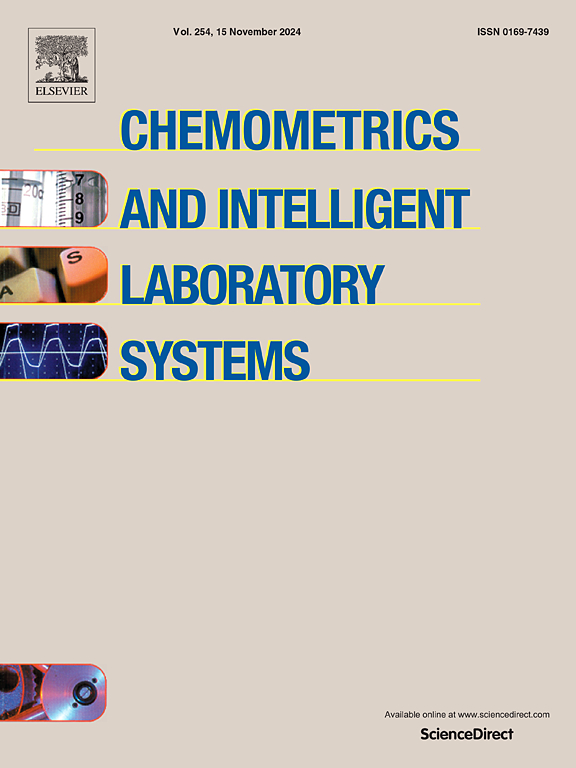化学计量学和电化学联手开发了一种新型智能电子设备,用于同时测定果汁中的马拉硫磷和二嗪农:多学科研究的进展
IF 3.7
2区 化学
Q2 AUTOMATION & CONTROL SYSTEMS
Chemometrics and Intelligent Laboratory Systems
Pub Date : 2024-10-18
DOI:10.1016/j.chemolab.2024.105249
引用次数: 0
摘要
在这项工作中,化学计量学和电化学相互结合,为食品工业专家开辟了一条新的途径,即开发一种新型电化学传感器,用于在果汁中同时测定马拉硫磷(MT)和二嗪农(DZ),以及作为非校准干扰的棒曲霉素(PT)和柠檬霉素(CT)。传感器的制作基于壳聚糖-离子液体(Ch-IL)对玻璃碳电极(GCE)的改性、金纳米粒子(Au NPs)的电沉积、多壁碳纳米管-IL(MWCNTs-IL)的滴铸以及以 MT 和 DZ 为模板的双模板分子印迹聚合物(DTMIPs)的电化学合成。实验变量对传感器结构和响应的影响分别通过 Min Run 筛选和中心复合设计进行了筛选和优化。优化后,以改变调制时间和调制幅度为仪器参数,生成三阶流体动力差分脉冲伏安法(HDPV)数据,并通过 N-PLS/RTL、U-PLS/RTL、U-PCA/RTL、APARAFAC、PARAFAC2 和 MCR-ALS 建模,选择最佳模型辅助传感器在水果样品中存在 PT 和 CT 未校准干扰的情况下超选择性地同时测定 MT 和 DZ。结果表明,MCR-ALS 是 DTMIPs/MWCNTs-IL/Au NPs/Ch-IL/GCE 在合成样品和实际样品中同时测定 MT 和 DZ(存在 PT 和 CT 未校准干扰)的最佳辅助传感器。在 MCR-ALS 的辅助下,传感器在同时测定 MT(0.1 pM-12.5 pM,LOD = 0.01 pM)和 DZ(0.25 pM-8.5 pM,LOD = 0.15 pM)的超选择性方面表现非常出色,可与带有紫外检测功能的 HPLC 相媲美,而与 HPLC-UV 相比,该方法更快、更简单、成本更低,这促使我们将其作为一种可靠的方法引入食品工业专家的质量保证工作中。本文章由计算机程序翻译,如有差异,请以英文原文为准。
Chemometrics and electrochemistry joined hands to develop a novel and intelligent electronic device for simultaneous determination of malathion and diazinon in fruit juices: A progress in multidisciplinary studies
In this work, chemometrics and electrochemistry connected to each other to open a new way for assisting food industry specialists based on developing a novel electrochemical sensor for simultaneous determination of malathion (MT) and diazinon (DZ) in the presence of patulin (PT) and citrinin (CT) as uncalibrated interference in fruit juices. The sensor was fabricated based on modification of a glassy carbon electrode (GCE) by chitosan-ionic liquid (Ch-IL), electrodeposition of gold nanoparticles (Au NPs), drop-casting of multiwalled carbon nanotubes-IL (MWCNTs-IL), and electrochemical synthesis of dual templates molecularly imprinted polymers (DTMIPs) in which MT and DZ were used as templates. Effects of experimental variables on structure and response of the sensor were screened and optimized by Min Run screening and central composite design, respectively. After optimization, the third-order hydrodynamic differential pulse voltammetric (HDPV) data were generated based on changing modulation times and modulation amplitudes as instrumental parameters and modeled by N-PLS/RTL, U-PLS/RTL, U-PCA/RTL, APARAFAC, PARAFAC2 and MCR-ALS to select the best one to assist the sensor for ultra selective simultaneous determination of MT and DZ in the presence of PT and CT as uncalibrated interference in fruit samples. The results confirmed the MCR-ALS was the best assistance for DTMIPs/MWCNTs-IL/Au NPs/Ch-IL/GCE for simultaneous determination of MT and DZ in the presence of PT and CT as uncalibrated interference in both synthetic and real samples. Performance of the sensor assisted by MCR-ALS for ultra selective simultaneous determination of MT (0.1 pM–12.5 pM, LOD = 0.01 pM) and DZ (0.25 pM–8.5 pM, LOD = 0.15 pM) was really admirable which was comparable with HPLC with UV detection while it was faster, simpler and low-cost in comparison to HPLC-UV which motivated us to introduce it as a reliable method to assist food industry specialists for quality assurance purposes.
求助全文
通过发布文献求助,成功后即可免费获取论文全文。
去求助
来源期刊
CiteScore
7.50
自引率
7.70%
发文量
169
审稿时长
3.4 months
期刊介绍:
Chemometrics and Intelligent Laboratory Systems publishes original research papers, short communications, reviews, tutorials and Original Software Publications reporting on development of novel statistical, mathematical, or computer techniques in Chemistry and related disciplines.
Chemometrics is the chemical discipline that uses mathematical and statistical methods to design or select optimal procedures and experiments, and to provide maximum chemical information by analysing chemical data.
The journal deals with the following topics:
1) Development of new statistical, mathematical and chemometrical methods for Chemistry and related fields (Environmental Chemistry, Biochemistry, Toxicology, System Biology, -Omics, etc.)
2) Novel applications of chemometrics to all branches of Chemistry and related fields (typical domains of interest are: process data analysis, experimental design, data mining, signal processing, supervised modelling, decision making, robust statistics, mixture analysis, multivariate calibration etc.) Routine applications of established chemometrical techniques will not be considered.
3) Development of new software that provides novel tools or truly advances the use of chemometrical methods.
4) Well characterized data sets to test performance for the new methods and software.
The journal complies with International Committee of Medical Journal Editors'' Uniform requirements for manuscripts.

 求助内容:
求助内容: 应助结果提醒方式:
应助结果提醒方式:


